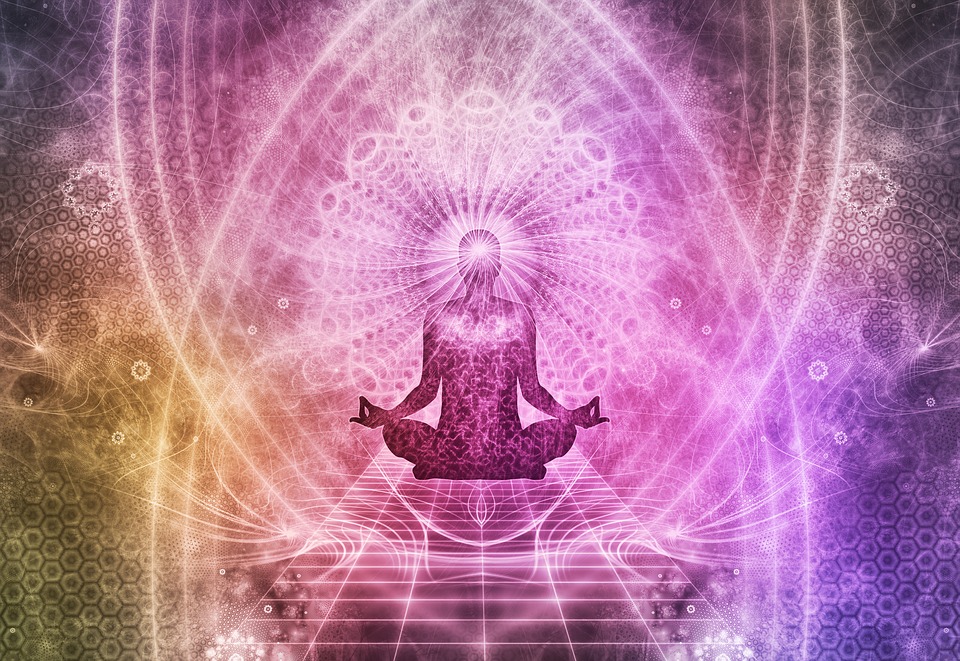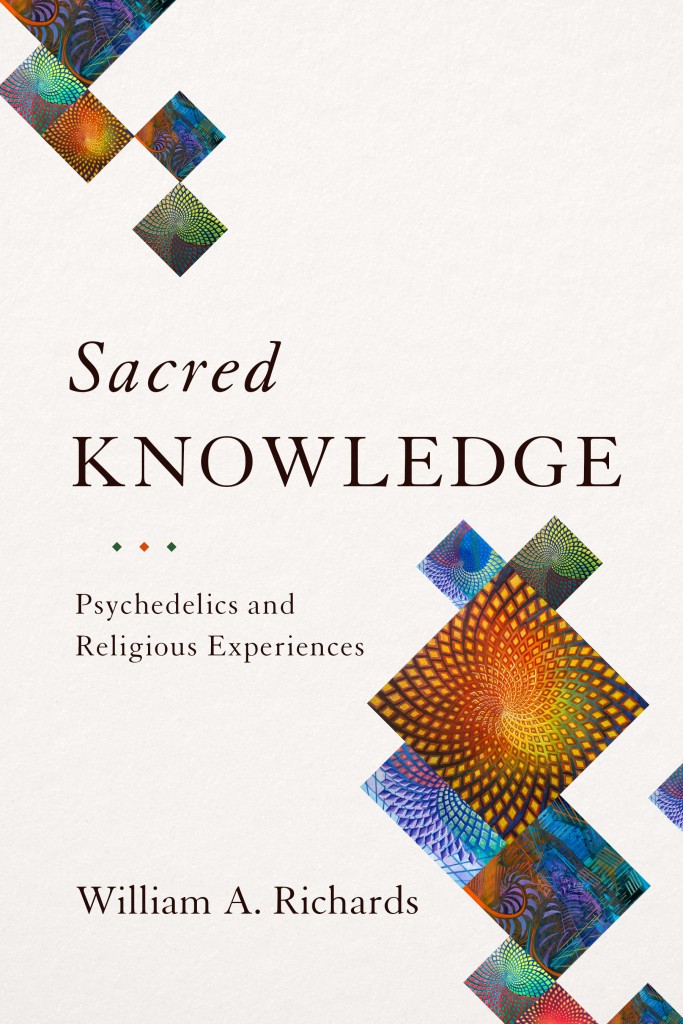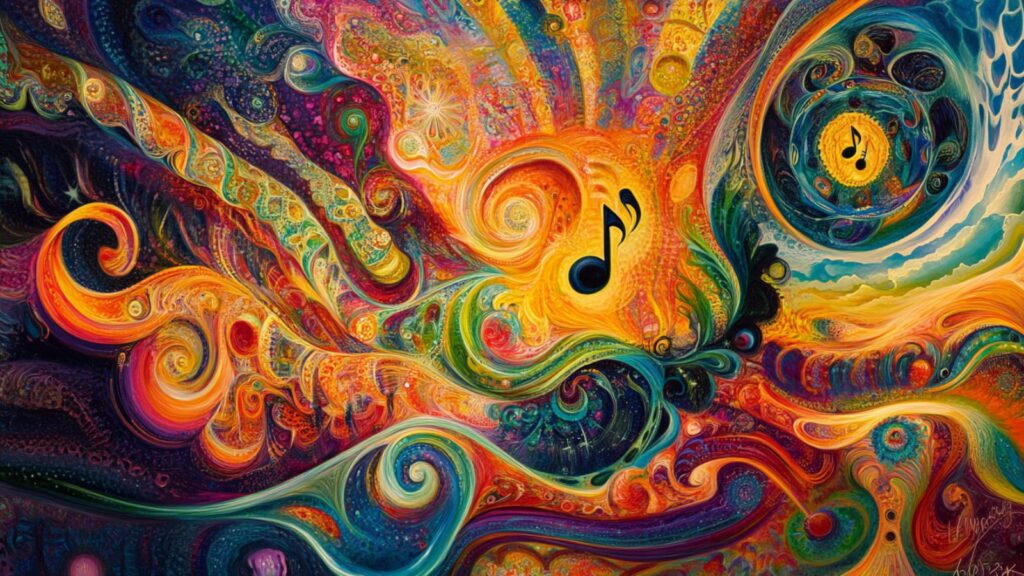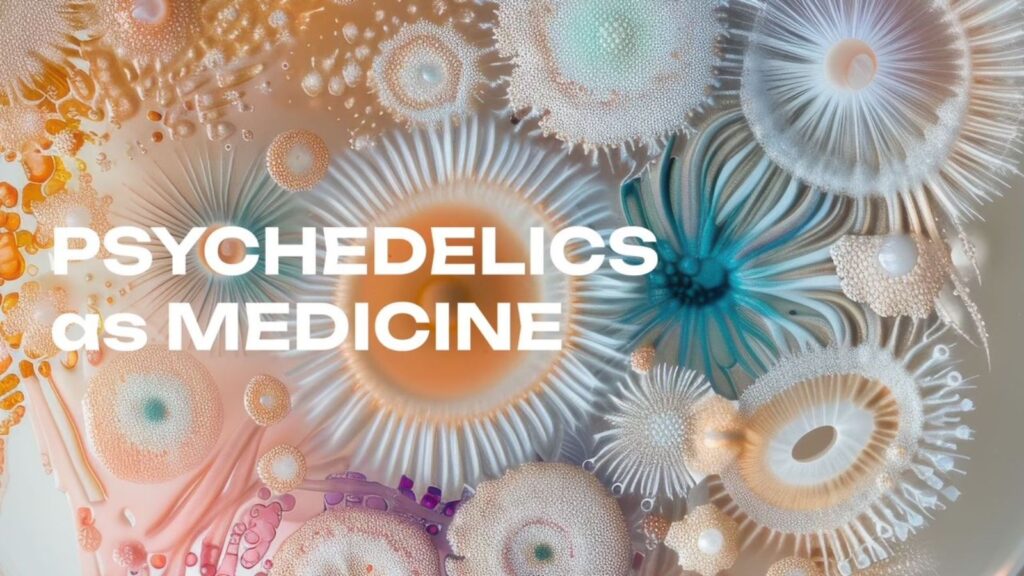The following is excerpted from Sacred Knowledge: Psychedelics and Religious Experiences by William A. Richards, published by Columbia University Press.
Join us at The Alchemist’s Kitchen in NYC on July 30 for a special screening of Psychedelic Mysticism: The Good Friday Experiment and Beyond. The film takes an inside look into the famous group experiment where students took psilocybin at the Marsh Chapel of Boston University in 1962. The screening will be followed by a discussion with Dr. William Richards and filmmaker Susan Gervasi, moderated by Christopher Kelley. Learn more here.
The world of religious scholarship often seems quite far removed from the world of private devotion and faith, sometimes with heavy reliance on intellectual processes and minimal regard for the intuitive matters of the heart and the experiential domains of the religious life. This scholarly disconnection struck me most poignantly during the final year of my theological studies at the Yale Divinity School, the year after I returned from the University of Göttingen. In Germany, I had attended lectures offered by seminal biblical scholars, including such luminaries as Joachim Jeremias, Hans Conzelmann, and Walther Zimmerli, to the envy of some of my fellow classmates at Yale. Yet strangely enough, I found my primary intellectual yearnings and spiritual inspiration nourished in lectures not in the theological division of the university, but by members of the psychiatric faculty in the School of Medicine. There I found courses such asReligionspsychopathologie (the psychopathology of religion) and a seminar on the religious delusions of schizophrenic patients that explored whether or not there were religious revelations that should not be considered evidence of mental illness. The conclusion was that there indeed were such experiences. There was also a course in self-hypnosis and meditative procedures (Schultz’s “Autogenic Training”) taught in a large auditorium filled primarily with medical students. Coupled with my personal experiences and internship opportunities with psychedelic substances in the psychiatric clinic with Hanscarl Leuner, it was clear to me that I had discovered the experiential dimension of religion being most intensely manifested in the medical division of the university. So it was that, when I returned to New Haven to complete the third and final year of the master of divinity degree, the area of specialization in which I felt most at home had changed from preparation for the pastoral ministry to what then was called “Teaching and Research in Religion.”
Back at Yale, one of the first seminars in which I enrolled was titled “The Theology of German Idealism.” It focused on writings of the philosophers Kant, Hegel, and Schelling and met around a heavy oak table in the Gothic Sterling Library with windows of tinted stained glass and oil paintings in elaborate gold frames of somber professors wearing academic robes who seemed to be looking down on us. As was the tradition then among graduate students of philosophy, who liked to think of themselves as quite independent, most all students wore tweed sport coats with leather patches on the elbows, rather wrinkled dress shirts with long ties, and denim blue jeans. This was in 1964, and serious philosophers also smoked pipes then, usually curved ones. Further, it was basically a men’s club and most everyone was bearded.
I vividly recall the day when, after reading that best seller by Immanuel Kant, titled The Critique of Pure Reason, we were seriously pondering a concept of Kant’s that he called “intellectual intuition,” debating whether or not it was possible directly to know spiritual truth. Kant himself tended to think it was not possible. Fresh from a visit to Baltimore’s Spring Grove Hospital, where alcoholics were receiving psychotherapy assisted by LSD under a grant from the National Institute of Mental Health, I found myself remembering a conversation with a man who had suffered from alcoholism, had been hospitalized, and had experienced a mystical form of consciousness during the action of LSD.
I was wearing a traditional tweed sport coat, dress shirt, and tie but, alas, had no leather patches on my elbows. Worse than that, I neither smoked a pipe nor had grown a beard. Nonetheless, I summoned the courage to raise my hand and say something like, “Well, I just visited a research center in Baltimore and spoke with an alcoholic who reported a mystical experience with LSD, and he said, ‘Yes, it is possible directly to know spiritual truth.’ ” A stunned, very awkward silence followed, as if I had violated a sacred academic taboo by introducing empirical information into a philosophical discussion. Time momentarily seemed to have stopped. Then, without anyone responding to my words, the drone resumed and debate continued with selected references to the writings of philosophers long dead whether such knowledge could be possible. It seemed incomprehensible that sophisticated Yale graduate students could learn anything from some alcoholic who had taken a drug.
Psychedelic substances are powerfully effective tools in the study of consciousness, and especially in the study of religious and mystical experiences. If understanding topics like conversion and revelation, and perhaps even the primal origin of religious ideas and sacred symbols, is relevant to religious scholars, why are university departments of religion not collaborating with colleagues who possess research skills in psychopharmacology and seeking the governmental and institutional authorizations currently required to pursue studies with entheogens? Would astronomers be content to pursue research without telescopes, or biologists without microscopes? Or, as mentioned earlier, would a scholar of life in Paris be content to remain within the confines of his college library, mastering the French language and reading French novels and guidebooks without ever walking the streets of the city, speaking with natives in sidewalk cafes, and experiencing the glories of the cathedrals there? Perhaps it is still too early, and religious scholars are just beginning to awaken from a long sleep to the incredible frontier that awaits them. Sociologists are known to have accused religious scholars as suffering from “cultural lag.”
Astronomers must sometimes tremble with awe when they look through their telescopes and behold the unfathomable beauty of distant galaxies, but they still manage to formulate hypotheses and make careful observations and measurements in advancing their field of knowledge. The same could be true of religious scholars who genuinely would like to better understand the “mind of God” and the mysteries of our own being. I do not believe that anything sacred would be profaned in such study; if anything, we might discover that areas of life and thought we may have considered profane are indeed being made sacred.
Underdeveloped Areas of Religious Thought
There are many exciting frontiers of thought awaiting further exploration by religious scholars. Wayne Teasdale, author of The Mystic Heart, one of the finest introductions to mysticism and the meditative life, was a pioneer in interrelating Christianity and Buddhism. Another visionary pioneer is Diana Eck, professor of comparative religion at Harvard, who has been building bridges of understanding between Christianity and Hinduism—for example, relating the Hindu concept of divine energy called Shakti to the Christian concept of the Holy Spirit. Huston Smith’s classic survey of world religions,The World’s Religions (titled in earlier editions The Religions of Man), reflects his profound appreciation of each of the great faiths, and is written from “within looking out” on the bases of his open-minded immersion in different realms of religious thought and practice as well as his warm personal relationships with leaders from varied religious heritages. Alan Watts, Jack Kornfield, Joseph Goldstein, and others have helped to make Buddhism accessible to Western minds. There is much to be learned from the study of each of the great world religions, and now study need not be limited to the scrutiny of ancient texts but also, with the wise use of psychedelic substances, could be approached within conscious experiencing. As one of many examples, I often think how those Jews, Christians, and Muslims who tend to be excessively serious and somber, if not dour, could benefit from the Hindu appreciation for lila, known as “divine playfulness.”
There was a time, not long ago, when many scholars of mysticism differentiated between “Eastern Mysticism” with its emphasis on unitive consciousness and “Western Mysticism” with its focus on the personal relationship with the Divine. Now, as discussed earlier, we know that many, if not most, people, Eastern or Western, can experience both of these forms of consciousness. Similarly, as discussed in the chapter on “Approaches to Unitive Consciousness,” it now appears that both “Internal Unity” and “External Unity,” far from representing two different cultures or ways in which nervous systems may function, appear to be potential experiences within the repertoire of many human beings.
Actually, the breadth of theological scholarship and personal experience within individual religious traditions can often be found to include both unitive consciousness and devotion to the divine in personal manifestations. Hinduism includes not only acknowledgment of the Atman/Brahman unity, but also worship of the Ishwara in forms such as Lord Shiva or Lord Krishna. Christianity spans both the abstract ground of being as described by Paul Tillich and devotion to the personal Jesus. I remember entering a Hindu temple on Krishna’s birthday, seeing smiling little children gathered around a crib in which rested a baby Krishna doll, and being struck with how similar it was to the typical manger scenes on Christmas Eve in the Christian tradition. The behavior of altar guild members is delightfully similar, whether polishing brass crosses, candlesticks, water bowls, or statues of different deities. While theological distinctions can always be made and valued, there is ample room to find meaningful similarities and connections within the faiths of the world, and perhaps to unite in projects of social service.
There are many theological phrases and concepts that can become illumined with new understandings. For example, consider the oft-quoted scripture from Exodus (33:20), “You cannot see God and live.” It would be easy to dismiss such an idea as simply wrong on the basis of the many people who indeed feel they have “seen God” and obviously are still alive. Yet many of them have experienced a death of the ego, or everyday self, in conjunction with the revelation of the eternal world, and in that sense were indeed “dead” when the visionary world manifested itself. Similarly, St. Paul wrote of “dying to self” in the process of becoming a “new being in Christ.” This invites clarification of language and provides opportunities for fresh theological reflections.
Thomas Roberts has written about the “five hundred year old blizzard of words,” triggered by the invention of the printing press and the access of the common man to sacred scriptures and theological commentaries. He now foresees a new religious era with less reliance on words and greater emphasis on direct primary religious experiences, and has written, “To most people who are even moderately experienced with entheogens, concepts such as awe, sacredness, eternity, grace, agape, transcendence, transfiguration, dark night of the soul, born- again, heaven and hell are more than theological ideas; they are experiences.” Such experiential understanding of religious concepts need not devalue traditional creeds and dogma, but can infuse symbolic language with new meaning, rendering it more accessible and comprehensible to those of us who now worship in the twenty-first century.
In regard to the theological concept of “sin,” entheogenic experiences tend to support movement away from a legalistic list of specific prohibited attitudes or acts toward an understanding of sin as estrangement or separation from the Divine. Entering into the world of time thus entails “original sin” as separation, though not necessarily as “fallen” or guilt-ridden. Matthew Fox is one theologian who has written about this new perspective, calling attention to what he called “Original Blessing.” Paul Tillich has similarly invited us to consider sin as estrangement from ourselves, one another, and the Ground of Being. Redemption or salvation, in contrast, may be seen as reestablishing a conscious connection with the sacred dimensions of consciousness.
Religious symbols can undergo a metamorphosis from intellectual concepts to spiritual realities bursting with significance. This is perhaps supremely manifested in the Roman Catholic doctrine of transubstantiation, in which the wine and bread of the communion elements may be spiritually experienced as the blood and body of the Christ and all the profound meanings that the symbols of “blood” and “body” can portray. Without deciphering the symbols, especially for those who have not grown up within a Christian tradition, the ritual of the mass may simply appear strange and bizarre, as if drinking blood and eating flesh were some primitive cannibalistic practice that unthinking modern men and women continue to reenact for unknown reasons. With more attunement to the spiritual dimension of life, there can be enhanced appreciation of the mysteries within the Eucharistic symbols, of the altar as a focal location in time and space where eternal verities and temporal existence may meet and where genuine spiritual nourishment may be obtained. Blood in particular appears to be a symbol often encountered in psychedelic experiences, not as something gory, but as a cleansing, vibrantly red, life-giving energy in the visionary world; this makes sense of the common religious phrase in the Judeo-Christian tradition “washed in the blood of the lamb.”
Understanding Prophets and Prophecy
Religious scholars tend to view prophets not primarily as “fore-tellers” but as “forth-tellers.” In the sacred scriptures of Judaism, Christianity, and Islam, there are many descriptions of visionary or archetypal experiences. In the wake of such revelations, prophets inspired by the alternative states of consciousness they experienced, such as Amos, Hosea, Isaiah, Ezekiel, Jeremiah, Zechariah, Zephaniah, and Muhammad, typically preached about the need for spiritual awakening, renewed ethical standards, and the importance of social justice. From an Islamic perspective, Isa, or Jesus of Nazareth, would be included in the list. Many of the descriptions of visionary experiences, expressed by these men or attributed to them, also stress the exalted, primary reality of God, utter humility in the divine presence, the potency of love and wrath, the reality of death, and the brevity of human life.
Would it be too radical to suggest that a similar visionary experience might prove instructive to a scholar of sacred scriptures? Rick Strassman in his bookDMT and the Soul of Prophecy has provided an initial impetus in this direction with his comparison of some of the DMT experiences reported by his subjects and writings by, or carrying the name of, the Hebrew prophets. Scholars have often focused on the meanings of the scriptural words in their original languages and have sought to reconstruct the historical, social, and political periods in which the prophets lived. In addition, experiential appreciation for the visionary realms that the prophets encountered could provide new vitality in religious studies.
Various religions in the world have focused on a single prophetic voice, a written document, or a collection of manuscripts and claimed it to be the final revelation of God to man. With due respect for individual systems of belief, it is clear that, though one may choose a definitive focus that one personally considers sufficient, in actuality revelation continues to occur, not only within particular religions but within human psyches with diverse languages, traditions, and orientations in different cultures of the world. It has been suggested by some who have experienced revelatory states of consciousness that, even if all the scriptures of the world were somehow lost, tragic as that event would be for history and literature as well as religions, in time similar scriptures with similarly profound spiritual insights would come to be written.
Scriptures, no matter how deeply revered, have never fallen out of the skies and hit prophets on their heads; they have always been written by inspired human beings who personally experienced alternate states of awareness in various sociopolitical settings and expressed the revelations they encountered as best they could in speech or writing. Often their followers, sometimes decades later, wrote down stories or poems that had been orally transmitted and edited the manuscripts as best they could. As the histories of organized religions have progressed, committees of scholars have prayerfully assembled to vote on which allegedly inspired manuscripts to include in their official scriptures and which to exclude. As encapsulated in the quotation by Paul Tillich in the frontispiece of this book, “God has not left himself unwitnessed.”
The Power of Decisions
Among the experiential learnings for religious scholars who could pursue research with psychedelic substances would be a clearer understanding of the role of choice or decision in religious lives. Evangelical Protestantism has especially emphasized the “decision for Christ,” an active act of choosing to be receptive, to entrust one’s self to something greater than one’s everyday personality, and to allow a sacred dimension of life, however conceptualized, to enter, change, and transform one’s being. This moment or process of awakening usually requires more than the passivity symbolized by listlessly lying on pavement while a steamroller approaches. Viewed from a psychological perspective, this also acknowledges the importance of ego-strength, how when one “has an ego” or some sense of a developed personal identity, it becomes easier under the right conditions to choose to relinquish ego controls. Perhaps this is why people in their mid-twenties and beyond may be more likely to experience transcendental states of consciousness during the action of entheogens than younger people amid the turmoil of adolescence. Yet, in view of the frequency with which conversion experiences spontaneously occur in many young adolescents in the contexts of evangelical religious groups, it would appear that some teenagers already possess an adequately strong sense of identity or selfhood.
In and Out of Theological Circles
In the process of interrelating my own Christian theological education and studies of world religions with the experiential knowledge derived from mystical and archetypal experiences, a conceptual tool I have found of significant value is Paul Tillich’s idea of the “theological circle.” Within the confines of a circle, one is immersed in the symbolism, language, and historical traditions of one’s religious faith, be it Christian, Hindu, or any of the other world religions. One feels the meanings and senses the dramas portrayed within the particular faith tradition and can thus enter into worship or meditative experiences as a full participant.
However, one can also at times step outside the circle, empowering the rational minds of the philosopher and scientist within us all. From this perspective, one can critically examine the contents within a particular circle and also relate and compare one circle with another. With sufficient training, one can even enter fully into a circle different from one’s childhood religion or culture. Here is a very practical application of the “Both/And” orientation that honors both the cognitive and the intuitive capacities with which we have been endowed. Scholars of religion need not be skeptical agnostics who always maintain a critical distance from their subject matter. Nor need they be so myopically focused on one particular religion that they ignore or devalue others. In this particular discipline, perhaps more than many others, the very essence of one’s being is involved in one’s area of study and one can both worship and think.
As one who values being a participant observer in religious traditions different from my own heritage, I recall praying at the Wailing Wall in the Old City of Jerusalem. Once my prayers were completed, as I walked the ascending pathway that led away from the wall, I saw an orthodox rabbi approaching me in a black robe with a very long white beard, sparkling eyes, and a warm smile. I looked forward to interacting with him and perhaps, however briefly, sharing something of our lives and mutual perspectives. He grasped my hands and looked me straight in the eye as we greeted each other. Then, he paused and slowly inquired, “Was your mother Jewish?” When I indicated a negative answer, his response was a very curt “have a good day” while he briskly walked away. Perhaps he was only in search of a tenth member for a minyan for public prayers, but he and I both missed an opportunity to really meet and to perhaps learn from each other.
In another attempt to enter deeply into a somewhat different religious tradition, I confess to having respectfully communed at the high altar of St. Peter’s Basilica in Rome even though I am officially a Protestant and had not gone to formal confession before communing as is usually expected in Catholicism. I am happy to report that I was not struck dead. My experiences of meditating in Buddhist, Hindu, and Sikh temples and in Islamic mosques have also been without incident and, frankly, I have often found them to be meaningful worship experiences. In the Episcopal parish where I find myself contributing as a musician on most Sunday mornings, I’m aware of sometimes entering into the circle of Christian dogmatics sufficiently to meaningfully recite and mentally decipher the historic Nicene Creed, even including the symbolic language “He ascended into heaven and is seated at the right hand of the Father.” At other times I discover that I have stepped outside the circle and, though still genuinely worshiping, am meditatively immersed privately in a Hindu or Buddhist chant.
The Jesus of History and the Eternal Christ
It was Carl Jung who posited that the archetype of the Christ is to be found within us all, irrespective of whether we grew up as Christians or whether we consider ourselves “believers.” The German theologian Martin Kähler is noted for making a distinction between the Jesus of history and the Christ of faith—the latter being the eternal archetype who always has been and who was before the birth of the historical man called Jesus of Nazareth and of course continued to be after his crucifixion. Within this framework of understanding, the eternal Christ dwells within each human being, regardless of religious or nonreligious systems of personal belief, and, as with Saul of Tarsus, who became St. Paul, may reveal himself in visionary experiences. This may also prove to be true of other major archetypes, including the Buddha and bodhisattvas, Hindu deities, Greek gods, and what Jung called “The Wise Old Man,” The Child,” and “The Great Mother.” If this proves to be validated by empirical research studies in the future, it may not be considered unusual for a Hindu to encounter the Christ or for a Christian to encounter Shiva or Vishnu.
Inquiry Into the Origins of Religions
For scholars interested in pursuing the possible role of entheogens in the origin of religions, there are intriguing frontiers to explore. Carefully researched books have been published by authors such as Robert Gordon Wasson, Huston Smith, Carl Ruck, Albert Hofmann, and Dan Merkur, suggesting that the soma described in the ancient Rig Veda, the kykeon drunk in the Eleusinian Mystery religions, and even the manna that the Israelites harvested in the early morning en route to Canaan may well have been species of psychoactive mushrooms. The archeologist and scholar of the Dead Sea Scrolls John Marco Allegro, in his book The Sacred Mushroom and the Cross,generated intense controversy by suggesting that references to Jesus in the Gospels may have been a code for the potentially sacred effects of a mushroom, Amanita muscaria, and the realms of spiritual knowledge thereby accessed. It is reported that, sensing the difficulties that many theologians would encounter in trying to understand his finding, he resigned from his position on the theological faculty of the University of Manchester when his book was published. Though he died in 1988, some of his insights, as well as those of other scholars, may well merit the careful continuing attention of those who possess the necessary knowledge to decipher ancient documents along with the courageous openness to seriously explore new perspectives.
Entheogens in Personal Religious Practice
If we turn from the world of scholarship to the personal practice of religion, the emerging cache of knowledge regarding the potential of entheogens, when wisely ingested, to nurture the spiritual awareness of those of us who desire experiential knowledge in our religious lives raises very practical questions. Clearly there are important issues that require discussion and resolution in medical, legal, and religious communities in the near future.
Many would assert that the freedom of religion enshrined by the Constitution of the United States and similar guarantees in other countries must eventually prevail over the cultural fears, fueled by governments who have attempted to suppress and control access to psychedelic substances in either their pharmacologically pure or their plant-based forms. When future historians look back on our era, I suspect they will find it hard to believe, if not totally ludicrous, that fears of consciousness exploration and religious experiences could ever have been so extremely out of control that a person could be subject to arrest if the wrong species of mushroom happened to sprout in his or her yard and especially if one should personally decide to consume it as a sacrament.
At the time of writing, it can be stated that the religious use of mescaline in the form of the Peyote cactus was declared legal in the United States in 1971 for members of the Native American Church. In addition, the US Supreme Court in 2006 recognized DMT in the brew called ayahuasca as a legitimate and legal sacrament of the União do Vegetal (UDV) religion. Use is currently legal for members of these specific religious organizations according to US federal law, though laws in the individual states may differ. Not surprisingly, the importation of the sacramental substances in the states that allow its presence allegedly remains closely monitored by the Drug Enforcement Administration to ensure that there is no diversion to so- called recreational users.
One may hope that continuing respectful and responsible attitudes toward these sacramental substances will gradually lead to them becoming legally accessible in the United States and elsewhere in other contexts where serious religious intent prevails. Perhaps the next step would be to extend legal authorization to retreat and research centers, staffed by professionals with both medical and religious training, who understand the art of wisely administering these substances to those who wish to receive them. Such centers could also provide individual and group support for the initial integration of psychedelic experiences. Although it may be a long time before psychedelic sacraments are incorporated into worship experiences in the churches, synagogues, mosques, and temples of major religious organizations, present religious leaders from diverse faith backgrounds could be supportive of such centers for research and retreat.
***














